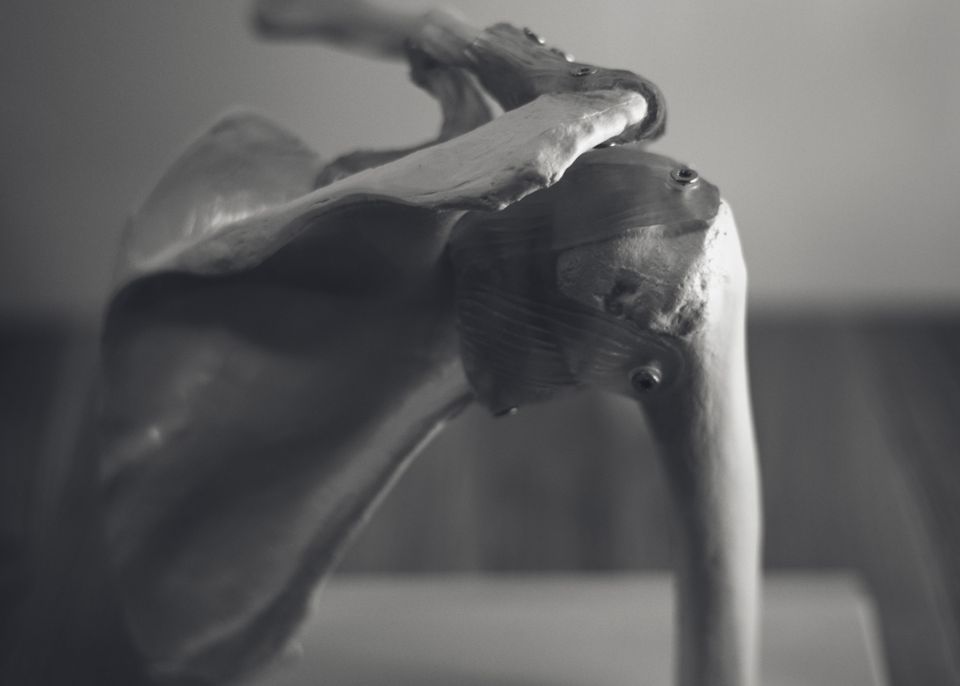Hey google, WTF is scapular dyskinesis?

Health care and fitness professionals have a tendency to make people afraid of normal human movements. The movement in question today is scapular dyskinesis and the scapulohumeral rhythm, which many believe there is a perfect ratio. What does the research have to say about our shoulder blades and how they move?
A good place to start would be to have a solid definition of what the ‘problem’ is and compare that to normal movement. Easy, right? Well maybe not. It all started off on a calm summer morning in 1944 (disclaimer: I have no idea what the day was actually like) when the idea that normal arm and shoulder blade movement happened at a 2:1 ratio when lifting your arm up1. This means that your arm moves 2x the amount of degrees that your scapula does, and anything outside of that, including tipping and winging, is abnormal2. When it comes to the body of evidence, the ratio fluctuates from 1:1 to 6:13 And the ratio changes depending on where your arm is4. WOW, that is a little bit different than 2:1. To add to the definition problem, scapular dyskinesis is seen as the shoulder being unstable due to not following normal motion3. This also falls apart when you see how the scapula is just supported by mostly muscles and a couple ligaments, so the typical definition of joint instability doesn’t apply3.
For the remainder of the article let’s pretend that the definition isn't flawed. If we look at how much of the healthy/pain-free population has ‘shoulder don’t move right’ we have a good report of 52.9%5, not to mention that there are also normal differences in scapulohumeral rhythm between shoulders in each individual6. This percentage jumped up significantly higher when the examiner was told that the person had shoulder pain (even if the person didn’t, sometimes little lies are necessary) which helps to show how biassed the assessment can be; if you want to see it you will.
Now that we know how prevalent it is in people who aren’t experiencing pain, does this mean that someone with scapular dyskinesis will develop pain and problems down the road? No3,5,7-9. That’s it, the majority of evidence says no. No matter how bad you want it to be as simple as ‘make your scapula move differently and you won’t have pain’ it just isn’t the case. Since it can’t be said that scapular dyskinesis causes pain and dysfunction, it may be an adaptive or compensatory movement strategy7,10-14 or a coincidental finding of normal movement variability5. One interesting bit of information that was found was that there tended to be more upward rotation with rotator cuff tears14-19 or a nerve block20 simulating them. This increased upward rotation of the scapula may be a positive adaptation14-20. Hold on… a positive adaptation you say!? That is really interesting because, if you can remember back to my previous post on rotator cuff tears, the physical therapy for the non-conservative treatment often consisted of muscular control, stability and maintenance of ‘normal’ scapular position. Allow me to go on a tangent here, but why would you try to correct and maintain a certain scapular position when the new scapular kinematics (movement) is actually seen as a positive adaptation. It seems as though the people who were prescribing and carrying out the exercise were not keeping up to date with the evidence. Hmmm, that must never happen… right?
ANYWAY, all shade aside, what does the evidence have to say about programs focused on scapular stability. A very recent 2022 study2 looked at a program that just strengthened the muscles around the scapula and a program that did that plus specific scapular stibilization exercises. The results? There was no benefit to adding in the scapular stabilization exercises. This study is consistent with the larger body of evidence showing that overall there is not really a benefit to doing specific scapular stability exercises3,14. Not only do they have no added benefit on pain, but they do not show a change in scapular kinematics (how your shoulder blades move) after the program2,3. Hotta2 explained that this is possibly due to how motor learning occurs. Doing all of those scapular stabilization exercises and learning how to do a movement in your everyday life happen independently of each other. Basically, they are two separate things and one does not necessarily translate to the other.
Thank you for coming to my ted talk. Now go out there and let your body move!
- Inman VT, Saunders JB, Abbott LC. Observations of the function of the shoulder joint. 1944. Clin Orthop Relat Res. 1996 Sep;(330):3-12. doi: 10.1097/00003086-199609000-00002. PMID: 8804269.
- Hotta GH, Alaiti RK, Ribeiro DC, McQuade KJ, de Oliveira AS. Causal mechanisms of a scapular stabilization intervention for patients with subacromial pain syndrome: a secondary analysis of a randomized controlled trial. Arch Physiother. 2022 Jun 1;12(1):13. doi: 10.1186/s40945-022-00138-1. PMID: 35642020; PMCID: PMC9158354.
- McQuade KJ, Borstad J, de Oliveira AS. Critical and Theoretical Perspective on Scapular Stabilization: What Does It Really Mean, and Are We on the Right Track? Phys Ther. 2016 Aug;96(8):1162-9. doi: 10.2522/ptj.20140230. Epub 2016 Feb 4. PMID: 26847012.
- McQuade KJ, Smidt GL. Dynamic scapulohumeral rhythm: the effects of external resistance during elevation of the arm in the scapular plane. J Orthop Sports Phys Ther. 1998 Feb;27(2):125-33. doi: 10.2519/jospt.1998.27.2.125. PMID: 9475136.
- Plummer HA, Sum JC, Pozzi F, Varghese R, Michener LA. Observational Scapular Dyskinesis: Known-Groups Validity in Patients With and Without Shoulder Pain. J Orthop Sports Phys Ther. 2017 Aug;47(8):530-537. doi: 10.2519/jospt.2017.7268. Epub 2017 Jul 6. PMID: 28683230.
- Matsuki K, Matsuki KO, Mu S, Yamaguchi S, Ochiai N, Sasho T, Sugaya H, Toyone T, Wada Y, Takahashi K, Banks SA. In vivo 3-dimensional analysis of scapular kinematics: comparison of dominant and nondominant shoulders. J Shoulder Elbow Surg. 2011 Jun;20(4):659-65. doi: 10.1016/j.jse.2010.09.012. Epub 2010 Dec 30. PMID: 21194980.
- Struyf F, Nijs J, Meeus M, Roussel NA, Mottram S, Truijen S, Meeusen R. Does scapular positioning predict shoulder pain in recreational overhead athletes? Int J Sports Med. 2014 Jan;35(1):75-82. doi: 10.1055/s-0033-1343409. Epub 2013 Jul 3. PMID: 23825003.
- Andersson SH, Bahr R, Clarsen B, Myklebust G. Risk factors for overuse shoulder injuries in a mixed-sex cohort of 329 elite handball players: previous findings could not be confirmed. Br J Sports Med. 2018 Sep;52(18):1191-1198. doi: 10.1136/bjsports-2017-097648. Epub 2017 Aug 7. PMID: 28784621.
- Hogan C, Corbett JA, Ashton S, Perraton L, Frame R, Dakic J. Scapular Dyskinesis Is Not an Isolated Risk Factor for Shoulder Injury in Athletes: A Systematic Review and Meta-analysis. Am J Sports Med. 2021 Aug;49(10):2843-2853. doi: 10.1177/0363546520968508. Epub 2020 Nov 19. PMID: 33211975.
- afarian Tangrood Z, Sole G, Ribeiro DC. Is there an association between changes in pain or function with changes in scapular dyskinesis: A prospective cohort study. Musculoskelet Sci Pract. 2020 Aug;48:102172. doi: 10.1016/j.msksp.2020.102172. Epub 2020 Apr 28. PMID: 32560873.
- Wassinger CA, Sole G, Osborne H. Clinical measurement of scapular upward rotation in response to acute subacromial pain. J Orthop Sports Phys Ther. 2013 Apr;43(4):199-203. doi: 10.2519/jospt.2013.4276. Epub 2013 Jan 14. PMID: 23321770.
- Thomas SJ, Swanik CB, Kaminski TW, Higginson JS, Swanik KA, Nazarian LN. Assessment of subacromial space and its relationship with scapular upward rotation in college baseball players. J Sport Rehabil. 2013 Aug;22(3):216-23. doi: 10.1123/jsr.22.3.216. Epub 2013 Apr 18. PMID: 23628891.
- Ratcliffe E, Pickering S, McLean S, Lewis J. Is there a relationship between subacromial impingement syndrome and scapular orientation? A systematic review. Br J Sports Med. 2014 Aug;48(16):1251-6. doi: 10.1136/bjsports-2013-092389. Epub 2013 Oct 30. Erratum in: Br J Sports Med. 2014 Aug;48(16):1396. PMID: 24174615.
- Ludewig PM, Reynolds JF. The association of scapular kinematics and glenohumeral joint pathologies. J Orthop Sports Phys Ther. 2009 Feb;39(2):90-104. doi: 10.2519/jospt.2009.2808. PMID: 19194022; PMCID: PMC2730194.
- Deutsch A, Altchek DW, Schwartz E, Otis JC, Warren RF. Radiologic measurement of superior displacement of the humeral head in the impingement syndrome. J Shoulder Elbow Surg. 1996 May-Jun;5(3):186-93. doi: 10.1016/s1058-2746(05)80004-7. PMID: 8816337.
- Graichen H, Stammberger T, Bonél H, Wiedemann E, Englmeier KH, Reiser M, Eckstein F. Three-dimensional analysis of shoulder girdle and supraspinatus motion patterns in patients with impingement syndrome. J Orthop Res. 2001 Nov;19(6):1192-8. doi: 10.1016/S0736-0266(01)00035-3. PMID: 11781023.
- Mell AG, LaScalza S, Guffey P, Ray J, Maciejewski M, Carpenter JE, Hughes RE. Effect of rotator cuff pathology on shoulder rhythm. J Shoulder Elbow Surg. 2005 Jan-Feb;14(1 Suppl S):58S-64S. doi: 10.1016/j.jse.2004.09.018. PMID: 15726088.
- Paletta GA Jr, Warner JJ, Warren RF, Deutsch A, Altchek DW. Shoulder kinematics with two-plane x-ray evaluation in patients with anterior instability or rotator cuff tearing. J Shoulder Elbow Surg. 1997 Nov-Dec;6(6):516-27. doi: 10.1016/s1058-2746(97)90084-7. PMID: 9437601.
- Yamaguchi K, Sher JS, Andersen WK, Garretson R, Uribe JW, Hechtman K, Neviaser RJ. Glenohumeral motion in patients with rotator cuff tears: a comparison of asymptomatic and symptomatic shoulders. J Shoulder Elbow Surg. 2000 Jan-Feb;9(1):6-11. doi: 10.1016/s1058-2746(00)90002-8. PMID: 10717855.
- McCully SP, Suprak DN, Kosek P, Karduna AR. Suprascapular nerve block disrupts the normal pattern of scapular kinematics. Clin Biomech (Bristol, Avon). 2006 Jul;21(6):545-53. doi: 10.1016/j.clinbiomech.2006.02.001. Epub 2006 Apr 5. PMID: 16603286.

Member discussion